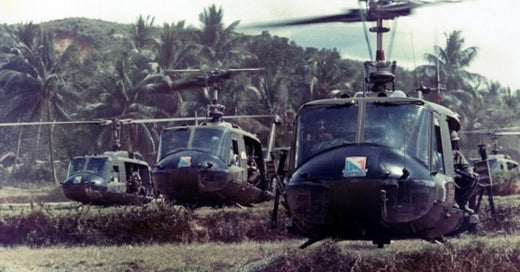This Fine Art Print by Artist Craig Tinder honors the "Huey" helicopter service during the Vietnam conflict. This Limited Edition Canvas Print includes an actual fragment from a surplus panel from UH-1C-BF "Huey" 65-9497 from Fort Stewart Hunter Army Airfield, in Georgia.
Details About the RELIC:
Originating from the UH-1C-BF "HUEY" 65-9497, this piece of fuselage bears witness to the aircraft's service in Vietnam. Post-service, the aircraft found its resting place at Fort Stewart Hunter Army Airfield, Georgia, until its ultimate disposal as scrap, a frequent end for many military vehicles.
 Panel from UH-1C 65-9497 - Pieces are included with each "Stacked Deck" canvas
Panel from UH-1C 65-9497 - Pieces are included with each "Stacked Deck" canvas
 Backside of panel
Backside of panel
 Artist, Craig Tinder with "Stacked Deck" limited edition canvas
Artist, Craig Tinder with "Stacked Deck" limited edition canvas
The Story Behind the Print:
In October 1968, UH-1C helicopter no. 14183 from the 229th Aviation Battalion (Assault Helicopter) embarked on an assault operation from the Ba To Special Forces Camp in Vietnam. The UH-1C gunship, an upgraded and highly versatile variant of the UH-1, was specifically designed for close air support and armed assault missions. Known for its powerful array of weaponry, this model could be equipped with machine guns, grenade launchers, and high-explosive rockets, making it one of the most feared and effective aerial platforms in the conflict. The UH-1C's armament and versatility allowed it to provide essential cover for ground troops, support air assaults, and engage enemy targets with precision.
 UH-1 Huey Helicopter
UH-1 Huey Helicopter
Although officially designated the "Iroquois," the helicopter’s original designation of HU-1 led to its enduring nickname, "Huey." The UH-1’s iconic design, with its distinctive rotor whine, became one of the most recognizable symbols of the Vietnam War. The helicopter’s role evolved from transport and medevac to combat assault, earning it a legendary reputation on the battlefield. Even after its official redesignation to UH-1, the nickname "Huey" stuck, becoming synonymous with the entire helicopter family.
The UH-1C variant, particularly suited for combat due to its reinforced frame and increased engine power, was an essential part of the U.S. Army’s air mobility strategy. It played a critical role in assault operations, like those from Ba To Camp, where its speed and firepower were instrumental in suppressing enemy forces and providing tactical air support for ground operations. The Huey’s legacy lives on, as it not only transformed the role of helicopters in warfare but also came to symbolize the intense air-ground coordination that characterized the Vietnam War.
Learn more about The Huey Helicopter’s Impact in Cultural Icon and Tactical Innovator? Click Here
To purchase or see similar items, visit here.
Commissioned by Museums, Treasured by Collectors





Share:
Beneath the Waves, the story behind "Silent Predator"
Training Legends, the story behind "Sunrise Kaydet"